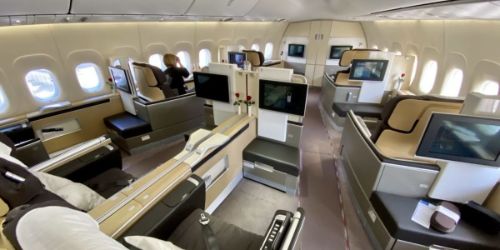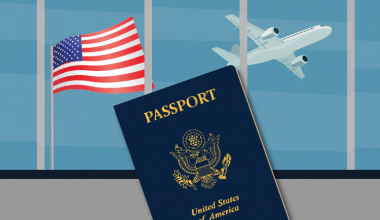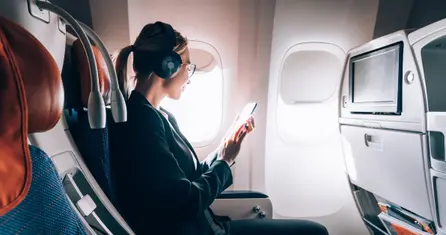Although the distinctions between first and business classes are not as stark as those between economy and first or business, there are still factors to consider when determining your travel plans. First class is generally twice as expensive as business class. However, this varies greatly depending on the route and airline.
Ben Schlappig, a consultant and travel writer who flies an average of 400,000 miles each year, said he almost exclusively seats in first and business class and has noticed a significant improvement in the business class area.
“Overall, we’re seeing more airlines abandon first class in favor of excellent business-class service, given that the market for first-class is quite limited.” “Schlappig explained. “Nowadays, business-class seats are superior to first-class seats. Meanwhile, some of our first-class seats presently feature out-of-this-world amenities such as double beds, bathrooms, or even sky apartments.”
Differences Between Business Class and First Class
Let’s go into detail about the differences between a first-class and business-class flight
#1. Waiting Times
Some benefits of the business or first-class travel might be expected to kick in on the ground—at the pre-boarding lounge. You’d be mistaken for the most part. The lounges, both first and business class, differ from country to country.
“Asia has the nicest lounges, followed by Europe and Australia,” Schalppig remarked. “Some first-class lounges in the United States are improving, particularly those run by foreign airlines. For example, Los Angeles International Airport has a beautiful Qantas first-class lounge.”
In Frankfurt, Lufthansa offers an individual lounge for first-class passengers, who can bypass the main terminal in favor of their own.
These passengers are then chauffeured to their flight in a Porsche or Mercedes. On the other hand, business-class lounges give a quiet room to work and rest, with fast Wi-Fi, comfortable chairs, and refreshments, but no other amenities.
The main differences between first and business class are the seats and the service. However, these differ depending on the airline, route, and airplane model.
#2. Comfort Levels
Business- and first-class services include a variety of enhancements and pleasures to assist you in getting a good night’s sleep and seclusion. Seatguru.com is the best source of information on flight configurations for any flight you are contemplating. Before purchasing your ticket, consider the following factors when deciding between business and first class: Will your seat become a bed? What is the layout of the cabin? What will your proximity to other travelers be? Will you have a double bed, your own “apartment,” or a seat that also serves as a bed?
For example, Emirates- First class Emirates is similar from plane to plane. Business-class travel.
First-class amenities usually precede business-class amenities on foreign flights rather than domestic flights but double-check to make sure.
#3. Food & Beverage
This is one of the two areas where business and first-class flights differ the most. “Business-class food is restaurant grade,” Schlappig added, “but dining in business class is rarely an experience.”
Customers in first class are frequently served cuisine prepared under the supervision of a celebrity chef. For example, Air France, ranked first in the world for in-flight food by the Robb Report, serves menus from Michelin-starred chefs.
When it comes to a drink with dinner, Singapore Airlines has “geniuses who specialize in knowing which wine fits well with each item on the in-flight menu offered to you when you’re above the clouds,” according to the UK-based Telegraph website.
Emirates and Korean Air feature onboard bars where you may socialize with your fellow passengers.
#4. Cost
If business class is a significant step up from a coach, first class is yet another significant step up. Personalized attention and an exceptional flight experience come at a hefty cost.
The price difference varies depending on origin, destination, and airline, but you should anticipate paying 2-5X more than economy for business class and 5-10X more for first class.
At the time of writing, the cheapest nonstop business class round-trip flight from Los Angeles to Paris Charles de Gaulle on Air France is $2,995.
A ticket for Air France’s famous first-class product, La Premiere, costs $11,222.
When using airline miles, the price difference between business and first-class might often be more. A business-class trip between the United States and London will cost at least 57,500 miles on the American AAdvantage program, while first class would cost at least 85,000 miles. In this situation, first-class costs slightly more than business class.
#4. Baggage checked
Business and first-class travelers almost always have more baggage allowance than economy passengers. Airlines’ policies differ, but you can generally expect two free checked baggage when traveling business class and three free bags when flying first class.
Priority-cabin bags are typically labeled as such, so they will be sent to baggage claim first when you arrive.
If the airline has a dedicated first-class check-in desk, the line to check luggage may be shorter for first-class passengers, saving you time.
#5. Lounge Access
When flying in a premium cabin, most airlines provide access to a lounge. There are sometimes separate business-class and first-class lounges for passengers, with first class having more luxurious amenities. Emirates, for example, has a first-class lounge exclusively for first-class travelers at its Dubai hub. The following is a list of specialized first-class lounges in major airports:
- Air France La Première lounge at Charles de Gaulle Airport in Paris (CDG)
- At London Heathrow, there is a British Airways Concorde Room (LHR)
- Dubai Emirates First Class Lounge (DXB)
- Frankfurt Lufthansa First Class Terminal (FRA)
- Qantas International First Lounge in Los Angeles (LAX)
- Doha’s Qatar Al Safwa First Lounge (DOH)
In some situations, the lounge access provided by a business- or first-class ticket will be identical. This is especially true for smaller, non-hub airports where a separate first-class lounge is not financially feasible. In some instances, you will not have access to the lounge. If lounge access is vital to you, do your homework before reserving to discover what each airline offers.
Some excellent first-class airline lounges provide a la carte cuisine, premium liquor, spa services, and private leisure areas. Business-class lounges typically have buffet cuisine and a great drink selection. However, some, such as the Whisky Club at the Zurich Senator Lounge, go out of their way to stand out.
#6. Boarding
First-class passengers are the first to board the plane and deplane when it arrives. First-class boarding is usually followed by business-class boarding.
The actual boarding procedure differs depending on the airline (though most board by group or zone). For example, Emirates allows premium-cabin passengers to board at their leisure, allowing them to escape the crowds at the gate and spend more time in the lounge.
#7. Seats
The overall spaciousness of the seat, the length of the lie-flat bed, the level of privacy, and the size of the in-flight entertainment screen are the critical differences between business-class and first-class seats. Business-class seats are often smaller and have shorter beds. If you’re taller than usual, the bed may feel too small. Many first-class items have totally enclosed suites with optimum seclusion.
International first and business classes almost always have lie-flat seats on intercontinental flights. Unless your flight is short or on a low-cost carrier, you should have plenty of legroom. On several airlines, business-class seats compete with first-class seats from prior decades.
Some airlines’ first-class seats are unequaled, such as Singapore Airlines’ renowned Suites product, in which your bed is entirely separate from your seat. If you’re traveling with a spouse, middle-seat pairs can be changed to double beds.
Pros and Cons of Flying Business Class
Pros of Flying Business Class
- Cheaper than the first
- More widespread than the first
- Improved onboarding service
Cons of Flying Business Class
- There is less space than before (but more than the economy)
- Less privacy than in the beginning
Pros and Cons of Flying First Class
Pros of Flying First Class
- The pinnacle of seclusion and onboard space
- Few travelers ever witness the such exceptional treatment.
- Possession of bragging rights
Cons of Flying First Class
- When compared to business class, it is more expensive.
- Onboard service might be time-consuming.
Airlines That Offer Both First and Business Class Services on International Flights
On long-haul flights, here’s an incomplete list of airlines that provide both business class and an even more luxurious first-class experience.
- Emirates
- Air France
- All Nippon Airways Inc.
- Singapore Airlines
- Cathay Pacific Airlines
- Airlines of Japan
- Etihad Airlines
- Korean Airlines
- Lufthansa
- SWISS
- Oman Airlines
- Qantas
- British Airways
Which one should you pick? First Class vs. Business Class
As with most travel gear, the final decision boils down to value. Passengers who have the money to spend and want an extraordinary travel experience will likely find reserving a first-class ticket beneficial; travelers who want a pleasant journey but aren’t drawn in by all the trappings of a first-class ticket may find a business class to be a better deal.
For example, on a seven-hour overnight flight between New York and Paris, a traveler who wants to maximize sleep time may prefer to have a quick bite in the lounge and then sleep the entire flight, so the onboard service differences between business and first may be irrelevant (provided the traveler does not require the extra space of a first-class bed to sleep well). However, on the roughly 13-hour straight flight from New York to Dubai, the extra space and amenities, in addition to a full night’s sleep, could easily be put to good use.
Travelers who want to fly international first class must also consider product retirement. International first class is becoming an anachronism, with many international carriers either decreasing the types of aircraft and itineraries that offer first-class service or discontinuing it entirely. Most US-based carriers have abandoned international first class in favor of business class seats, with American Airlines remaining the lone survivor.
Conclusion
First class is an excellent choice if you’re seeking the ideal trip memory and have the money to spend. However, business class will provide enough extra comfort and service to seem like a luxury if you’re upgrading from the economy.
Whatever cabin is ultimately selected, it goes without saying that a trip in international first or business class will be memorable—for all the right reasons.
Frequently Asked Questions
Is business class or first class better?
Regarding luxury, first-class outperforms business class in more ways than one, including first-class seats, restaurant-level meals, top-shelf drinks, private lounges, and aircraft service.
Which is more expensive, first-class or business class?
First class is generally twice as expensive as business class. However, this varies greatly depending on the route and airline.
Is it worth it to fly business class?
Business class on long-haul international flights is virtually always worthwhile. You’ll get a lie-flat seat with adequate privacy. Depending on the length of the journey, you’ll also be served one or two meals. These meals will be significantly superior to those served in economy class.
Why is business class so expensive?
Depending on the airline, business class has benefits such as priority boarding, luxurious seats with more legroom, gourmet food service, premium beverages, access to lounges, and more. This is why it is more expensive than an economy ticket.
Can an average person fly business class?
Anyone can purchase business-class tickets. You can fly business class, whether visiting relatives, visiting a distant nation for vacation, or going across the Pacific on a business trip.
Can you sleep in business class?
If you need to be well-rested when you arrive, Business Class is ideal. Business Class seats are always more comfortable than Economy seats. Several airlines have seats that convert into fully-flat beds, allowing you to lie down and sleep during the journey.
Related Articles
- How to Send a Letter: Guidelines, Costs, and Other Mailing Options
- UBER WORTH: Is Driving for Uber Worth It?
- BUSINESS PRODUCTIVITY TOOLS: Definition and Best Productivity Tools
- UNITED AIRLINES LOGO: Meaning, History, and Why the Logo Was Changed
- CAN YOU FLY WITH AN EXPIRED ID? TSA Requirements For Flying






